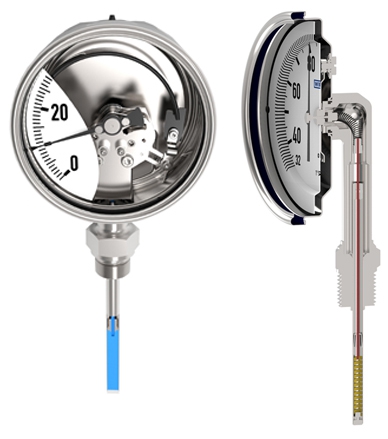
Which dial thermometer is suitable for which process? Whether a bimetal or a gas-actuated thermometer is used depends on several factors – for example, on the process temperature.

Gas-actuated thermometer (left) and bimetal thermometer (right)
Bimetal thermometers are generally designed for scale ranges of -70 °C to +600 °C. This only applies, in this respect, for unfilled instruments. When there are vibrations in the process, the operator must often resort to thermometers with liquid filling. The silicone oil used within dampens the vibrations. However, this limits the possible upper temperature in the process to +250 °C.
Gas-actuated thermometers generally operate reliably in the process between -200 °C and +700 °C. However, the operator must consider the ambient temperature here. With ambient temperatures of 23 °C ± 10 °C, WIKA guarantees accuracy class 1 of EN13190. However, the lower the gas volume, the harder this can be to maintain. For an exact measurement of the process temperature, the thermometer must be dimensioned appropriately:
- The stem diameter should be at least 8 mm
- The active part of the thermometer, i.e. the temperature sensor filled with gas, should be at least 100mm long
With bimetal thermometers, the ambient temperature has no influence on the measuring result. Therefore, these instruments can be used with external conditions down to -50 °C. The insertion length and the diameter of the stem are by no means to be disregarded: for an optimal measurement both should be dimensioned as large as possible.
Note
Further information on both instrument types can be found on the WIKA website under the headings “Dial thermometers” and “Thermometers with switch contacts”.
Learn more about the differences between bimetal and gas-actuated thermometers in the following video:
See also our articles
Selection criteria for mechanical thermometers (1): Response time
Selection criteria for dial thermometers (3): Capillary

